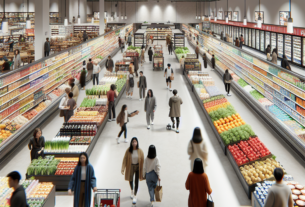The future of cashless restaurants is a topic that has been gaining attention in recent years as technology continues to advance and consumer preferences shift towards more convenient and efficient payment methods. In this report, we will explore the growing trend of cashless restaurants, including the benefits and challenges associated with this shift, as well as the potential impact on the foodservice industry as a whole.
The Rise of Cashless Restaurants
Cashless restaurants, also known as cash-free or cashless eateries, are establishments that do not accept cash as a form of payment. Instead, customers can pay using credit or debit cards, mobile payment apps, or other electronic payment methods. The concept of cashless restaurants has been gaining popularity in recent years, driven by a combination of factors including advances in technology, changing consumer preferences, and the desire for increased efficiency and convenience.
One of the main reasons for the rise of cashless restaurants is the increasing use of mobile payment apps and digital wallets. Apps like Apple Pay, Google Pay, and Samsung Pay have made it easier than ever for consumers to make purchases using their smartphones, eliminating the need for cash or physical credit cards. This trend has been further accelerated by the COVID-19 pandemic, which has led to a greater emphasis on contactless payment methods to reduce the risk of spreading the virus.
The Benefits of Cashless Restaurants
There are several benefits to cashless restaurants for both consumers and business owners. For consumers, cashless payment methods offer increased convenience, faster transaction times, and greater security. With mobile payment apps, customers can easily pay for their meals without having to carry cash or worry about losing their credit cards. Additionally, cashless transactions are often faster and more efficient than cash transactions, leading to shorter wait times and improved customer satisfaction.
For business owners, cashless restaurants can help streamline operations, reduce the risk of theft and fraud, and improve overall efficiency. By eliminating the need to handle cash, restaurants can save time and resources that would otherwise be spent on counting, storing, and transporting physical currency. Cashless transactions also provide a more accurate record of sales and revenue, making it easier for owners to track financial performance and make informed business decisions.
Challenges and Considerations
While cashless restaurants offer many benefits, there are also challenges and considerations to take into account. One of the main concerns with cashless establishments is the potential for excluding certain segments of the population who may not have access to electronic payment methods. This includes individuals who do not have bank accounts, credit cards, or smartphones, as well as those who prefer to pay with cash for privacy or security reasons.
To address this issue, some cashless restaurants have implemented alternative payment options such as prepaid cards or gift cards that can be purchased with cash. Others have partnered with third-party payment processors to offer cash-to-card services that allow customers to convert cash into electronic funds for payment. These solutions help make cashless restaurants more inclusive and accessible to a wider range of customers.
Market Trends and Data
According to a recent study by the National Restaurant Association, cashless payment methods are becoming increasingly popular among consumers, with 62% of diners reporting that they prefer to pay with a credit or debit card. In addition, the study found that cashless restaurants are more likely to attract younger customers, with 75% of millennials and Gen Z consumers saying they would choose a cashless restaurant over one that accepts cash.
In terms of market share, cashless restaurants currently represent a small but growing segment of the foodservice industry. A report by Technomic Inc. estimates that cashless restaurants account for approximately 5% of all restaurants in the United States, with projections indicating that this number is expected to rise to 10% by 2025. This growth is driven by increasing consumer demand for convenience and technology-driven experiences, as well as the ongoing shift towards a cashless society.
Financial Implications
From a financial perspective, cashless restaurants can benefit from lower operating costs, reduced risk of theft and fraud, and improved transaction efficiency. By eliminating cash handling and processing fees, restaurants can save money on banking fees, armored car services, and labor costs associated with cash management. In addition, cashless transactions are often more secure and less prone to errors, leading to fewer discrepancies and losses.
Despite these advantages, there are also costs associated with implementing cashless payment systems, including upfront investment in hardware and software, transaction fees charged by payment processors, and ongoing maintenance and support expenses. Business owners must carefully weigh the potential benefits and drawbacks of going cashless to determine the financial impact on their operations and profitability.
Future Outlook and Recommendations
Looking ahead, the future of cashless restaurants appears promising as technology continues to evolve and consumer preferences evolve. To capitalize on this trend, restaurant owners should consider implementing cashless payment options to attract more customers, improve operational efficiency, and stay competitive in the market. This may involve partnering with payment processors, upgrading POS systems, and training staff on how to process electronic payments effectively.
In addition, restaurant owners should prioritize customer education and communication to ensure a smooth transition to cashless operations. This includes informing customers about the benefits of cashless payments, providing clear instructions on how to use mobile payment apps, and addressing any concerns or questions that may arise. By taking a proactive approach to cashless technology, restaurants can enhance the overall dining experience and drive growth in an increasingly digital world.
In conclusion, the future of cashless restaurants is a growing trend that offers numerous benefits and opportunities for both consumers and business owners. By embracing technology, streamlining operations, and addressing key challenges, cashless restaurants can position themselves for success in an evolving industry landscape. As consumer preferences continue to shift towards more convenient and efficient payment methods, cashless restaurants are likely to become an integral part of the foodservice industry in the years to come.



